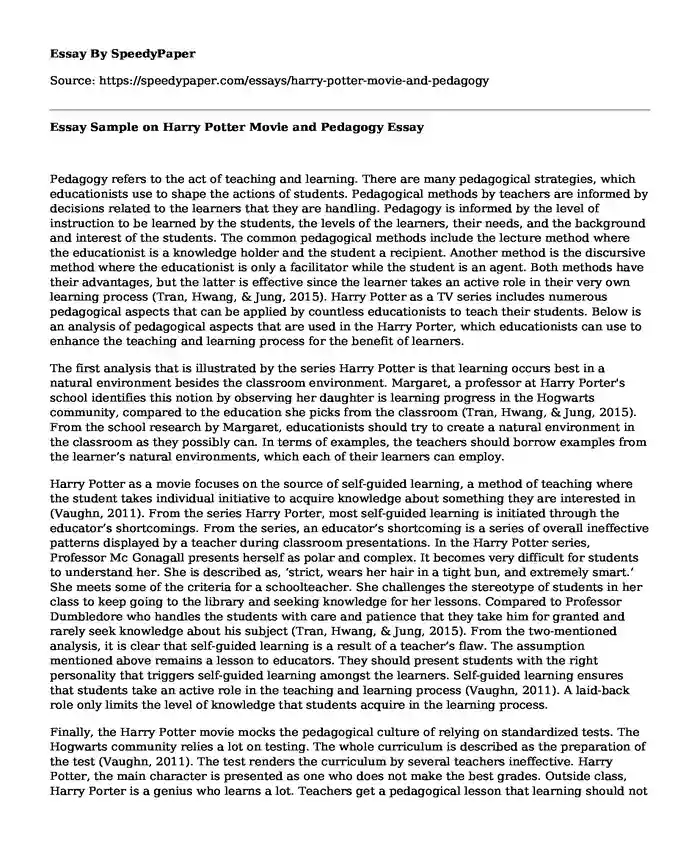Pedagogy refers to the act of teaching and learning. There are many pedagogical strategies, which educationists use to shape the actions of students. Pedagogical methods by teachers are informed by decisions related to the learners that they are handling. Pedagogy is informed by the level of instruction to be learned by the students, the levels of the learners, their needs, and the background and interest of the students. The common pedagogical methods include the lecture method where the educationist is a knowledge holder and the student a recipient. Another method is the discursive method where the educationist is only a facilitator while the student is an agent. Both methods have their advantages, but the latter is effective since the learner takes an active role in their very own learning process (Tran, Hwang, & Jung, 2015). Harry Potter as a TV series includes numerous pedagogical aspects that can be applied by countless educationists to teach their students. Below is an analysis of pedagogical aspects that are used in the Harry Porter, which educationists can use to enhance the teaching and learning process for the benefit of learners.
The first analysis that is illustrated by the series Harry Potter is that learning occurs best in a natural environment besides the classroom environment. Margaret, a professor at Harry Porter's school identifies this notion by observing her daughter is learning progress in the Hogwarts community, compared to the education she picks from the classroom (Tran, Hwang, & Jung, 2015). From the school research by Margaret, educationists should try to create a natural environment in the classroom as they possibly can. In terms of examples, the teachers should borrow examples from the learner’s natural environments, which each of their learners can employ.
Harry Potter as a movie focuses on the source of self-guided learning, a method of teaching where the student takes individual initiative to acquire knowledge about something they are interested in (Vaughn, 2011). From the series Harry Porter, most self-guided learning is initiated through the educator’s shortcomings. From the series, an educator’s shortcoming is a series of overall ineffective patterns displayed by a teacher during classroom presentations. In the Harry Potter series, Professor Mc Gonagall presents herself as polar and complex. It becomes very difficult for students to understand her. She is described as, ‘strict, wears her hair in a tight bun, and extremely smart.’ She meets some of the criteria for a schoolteacher. She challenges the stereotype of students in her class to keep going to the library and seeking knowledge for her lessons. Compared to Professor Dumbledore who handles the students with care and patience that they take him for granted and rarely seek knowledge about his subject (Tran, Hwang, & Jung, 2015). From the two-mentioned analysis, it is clear that self-guided learning is a result of a teacher’s flaw. The assumption mentioned above remains a lesson to educators. They should present students with the right personality that triggers self-guided learning amongst the learners. Self-guided learning ensures that students take an active role in the teaching and learning process (Vaughn, 2011). A laid-back role only limits the level of knowledge that students acquire in the learning process.
Finally, the Harry Potter movie mocks the pedagogical culture of relying on standardized tests. The Hogwarts community relies a lot on testing. The whole curriculum is described as the preparation of the test (Vaughn, 2011). The test renders the curriculum by several teachers ineffective. Harry Potter, the main character is presented as one who does not make the best grades. Outside class, Harry Porter is a genius who learns a lot. Teachers get a pedagogical lesson that learning should not be dictated by standardized tests, but considered a natural process.
In conclusion, Harry Potter the movie focuses on tests, teacher personality, and the environment of learning as the main pedagogical issues that dictate a student’s ability to acquire knowledge.
References
Tran, Q. D., Hwang, D., & Jung, J. J. (2015). Movie summarization using characters network analysis. In Computational Collective Intelligence (pp. 390-399). Springer, Cham.
Vaughn, M. E. (2011). Keeping It Real: Teaching and Learning in the Harry Potter Series.
Cite this page
Essay Sample on Harry Potter Movie and Pedagogy. (2023, Aug 06). Retrieved from https://speedypaper.com/essays/harry-potter-movie-and-pedagogy
Request Removal
If you are the original author of this essay and no longer wish to have it published on the SpeedyPaper website, please click below to request its removal:
- Change Management in Education, Essay Sample for Your Academic Purposes
- Admission Essay Sample for the Masters Program in Public Administration
- Essay Example: Overcoming Selfishness on the Way to Find Jesus
- Essay Sample: Fear and Anxiety in Learning a Foreign Language
- Essay Sample on Stuart Hall's Theory of Media - Encoding/Decoding
- Essay Sample on Group Poster Reflection Sheet
- Social Media "Likes" - Paper Sample
Popular categories





